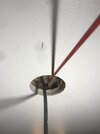I am using a bosch holesaw with my Makita cordless drill.
I find that this is often hit-and-miss for me. On occasions it will work fine and provide a nice clean hole and on other occasions it will jerk aggressively and even mark some of the teeth outside the hole area as it has slipped and inflict force against my wrist.
I think it goes wrong when I am being slow and careful with my drill. Is the idea to do this with maximum revs on the drill?
I find that this is often hit-and-miss for me. On occasions it will work fine and provide a nice clean hole and on other occasions it will jerk aggressively and even mark some of the teeth outside the hole area as it has slipped and inflict force against my wrist.
I think it goes wrong when I am being slow and careful with my drill. Is the idea to do this with maximum revs on the drill?



